Trello is one of the most user-friendly tools for small teams. Intuitive kanban boards make it easy to visualize workflows. All work within a project is divided into specific stages.
A manager can check the team’s workload at any time and be sure of the status of tasks. In this way Trello simplifies the planning and control of work execution.
Why are users looking for alternatives to Trello?
Although the system’s capabilities are extensive, they may still be insufficient for some teams. Some of the popular reasons for looking for alternatives to Trello are: scalability issues, insufficient tools, limitations in customization and building complex processes.
Top reasons to look for an alternative to Trello in 2025
 Limited capacity for complex workflows
Limited capacity for complex workflows
Trello does not support multi-level tasks and subtasks. In addition, the system lacks a Gantt chart for planning timelines and tracking dependencies between tasks. These limitations of Trello make it difficult to manage complex projects.
 Insufficient set of tools for resource control
Insufficient set of tools for resource control
Trello does not have built-in tools for time tracking and resource management. They are important for service business owners to analyze where the team’s focus is directed. Having a time tracker allows you to highlight inefficient resource allocation and calculate the cost of work.
The Worksection timer is available on all paid plans. With its help, a business can control the amount of time spent on a task and plan its work based on facts.
 Scalability issues
Scalability issues
The lack of hierarchical task structure in Trello can cause chaos in workflows. Therefore, as the team grows and the number of projects increases, the use of Trello may become less efficient.
 Limited opportunities for integration and customization
Limited opportunities for integration and customization
Extending Trello functionality often requires the use of third-party plugins and integrations. This also implies additional costs and efforts for customization and integration, which not everyone can afford.
How do other tools address these issues?
As a result, companies are looking for more flexible Trello alternatives that better meet business objectives and allow for more efficient project management.
For example, Worksection’s functionality offers:
- Advanced task management capabilities: Worksection provides not only kanban boards but also Gantt charts, allowing you to plan and track complex projects with timelines and dependencies.
- Time and resource management: The integrated time tracker and reporting system helps to control time and resource costs, which is especially important for service companies.
If you need agile task management and process automation, Asana, ClickUp and Monday.com are great choices. They support Agile methodologies, Gantt charts and SCRUM boards, and offer built-in reports and analytics without the need for external integrations.
For technical teams working with DevOps, Jira and Wrike are optimal. They provide deep integration with development processes, backlog, sprint and resource management, and detailed reporting.
If collaboration and ease of use are important, you should choose Basecamp or Notion. These platforms offer a minimalistic interface, task organization and record keeping, which is ideal for small teams and freelancers.
Criteria for selecting a project and team management system
The choice of a task manager depends on the specifics of the business, team size and key tasks. The tool should help in organizing work and at the same time meet the company’s specific requirements.
Team size and business specifics
For small teams and startups, simplicity and convenience are important so that employees quickly adapt to the new tool. Minimal functionality, a clear interface and the ability to manage multiple tasks without complex customization are the main criteria for selection.
Medium and large companies work with a large number of tasks and participants. This requires flexibility in customization, the ability to manage resources, control deadlines and integrate with other services.
Technical teams and developers often need specialized tools that support Agile methodologies, SCRUM, process automation, and advanced analytics.
Basic business needs
First of all, it is important to determine what business tasks the system should solve. If the main goal is to organize and manage tasks, a simple task manager with convenient process visualization will do.
Tools with Gantt charts, time tracking and detailed reporting are needed to monitor deadlines, resources and dependencies between processes. If it’s important to analyze team performance, automation features, reports and flexible performance metrics are useful.
Limitations: budget and adaptation
Fees can be flat per team or charged per user. Note that some tools also offer free plans, but their functionality may be limited.
It is also important to estimate the time to adapt the system. Simple platforms can be mastered more quickly. Complex solutions may require additional training of employees. Therefore, check the quality of technical support and the availability of onboarding.
The best alternatives to Trello in 2025
In this article, we take a look at the top 10 best alternatives to Trello in 2025. Let’s familiarize ourselves with them:
Worksection
Worksection is the best project management tool that combines ease of use with functionality. Worksection is ideal for small and medium-sized teams in different fields, from marketing to architecture.
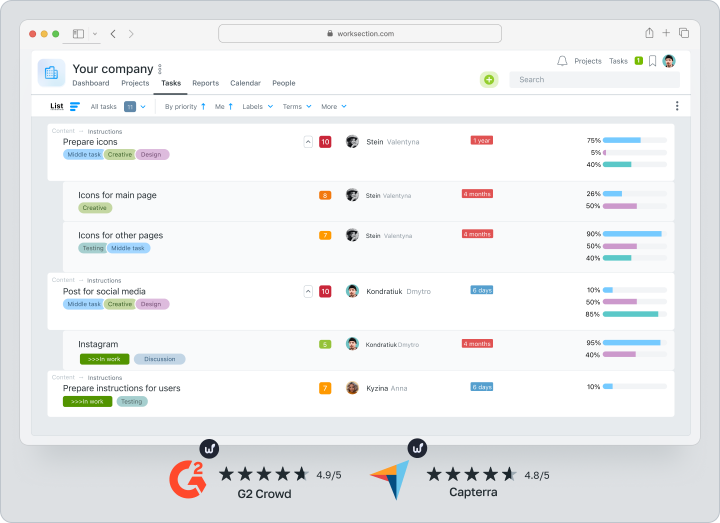
Unlike Trello, Worksection offers not only the usual kanban boards for task visualization, but also other project management tools. Built-in time tracker, task manager, Gantt charts, detailed system of reporting on the work of teams — everything for efficient control of work processes.
| Cost | Free plan is available | Price from $3.4 per user/month |
Key features
- Built-in analytics and reporting.
The system automatically collects data on task completion, deadlines and team utilization to help managers make informed decisions. - Gantt-diagrams and time-tracking.
Provide visual task planning and time tracking. This is especially useful for companies with clear deadlines for hourly wage projects. - Flexible configuration of access rights.
Allows to differentiate access levels between employees, clients and contractors.
Pros and cons
Benefits:- User-friendly interface: Easily adaptable for both new users and experienced managers.
- Process Automation: Built-in reminders, triggers and integrations reduce routine operations and increase efficiency.
- Suitable for scaling: Convenient for small teams and for large organizations with many parallel projects.
- Requires time to master: The platform has a wide range of functionality, which can take time to train a team. For faster integration, the service provides personalized consulting and training.
- Limited interface customizations: You can’t fully customize the appearance to suit individual company preferences.
Asana
Asana is a comprehensive solution for team management. The strength of the service is its flexibility. You can adapt the platform to different methodologies, be it Agile, Kanban or Waterfall. Like Worksection the system helps teams to clearly organize work and track progress.
Asana is ideal for mid-sized business owners and for large organizations that need to coordinate on multiple levels.
| Cost | Free plan is available | Price from $10.99 per user/month |
Key features
- Workflow Automation.
The platform allows you to create automated actions, reducing routine tasks and increasing overall team productivity. - Support for multiple templates.
Asana offers a variety of pre-defined templates for different industries and project types, which speeds up system customization and implementation. - Intuitive interface.
The design of the platform has been developed in such a way that users can quickly learn the functionality and start working without lengthy training.
Pros and cons of Asana
Benefits:- Several ways to display tasks: List, calendar, kanban board, timeline.
- Easy to learn: User-friendly interface that is intuitive even for new users.
- High level of system customization for specific requests of companies of different profiles.
- For teams with limited budgets, the cost of Asana can be high.
- If you want to work on an hourly basis, the time tracker tool is only available on the Advanced plan and above.
Monday.com.
Monday.com is a project management platform designed to optimize teamwork and automate business processes. Its flexibility and high customizability make the system attractive to different types of organizations along with Trello.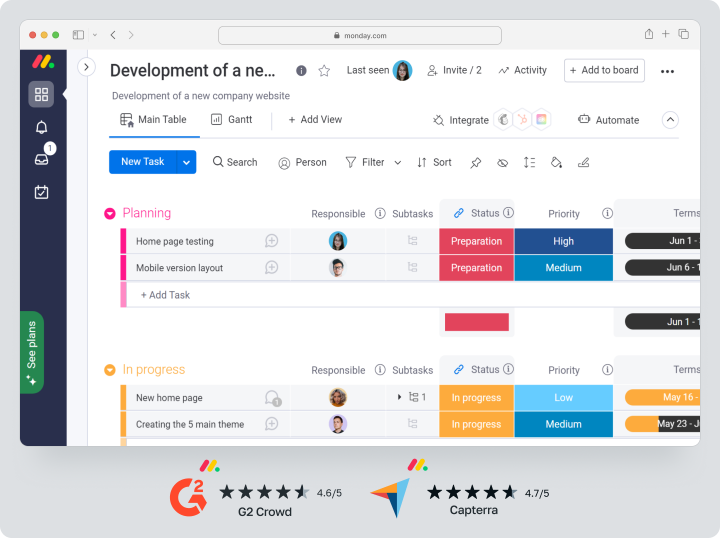
Monday.com is a good fit for teams that strive for efficient project management and value the ability to customize processes to fit their needs.
| Cost | Free plan is available | Price from $10 per user/monthh |
Key features
- Flexibility to customize workflows.
Users can customize the platform to their needs by creating unique boards, task statuses and dependencies between project stages.
By the way, Worksection also has a function of custom statuses. They help to build unique business processes and control project stages in a structured way. - Integration with popular services.
Monday.com connects easily with different tools, allowing you to work with your data without having to constantly switch. - Ready-made templates for different tasks.
Monday.com provides a wide range of templates customized for different businesses and project types.
Pros and cons
Benefits:- Great for large teams of 100 people or more who need a centralized platform to automate workflows.
- Support for Agile methodologies, which includes tools for sprint management, backlogging, bug tracking and roadmap building.
- The built-in CRM system helps to organize work with clients, track communications and manage transactions without the need for third-party CRM solutions.
- The platform can be too expensive for small teams and startups.
- The wide functionality and abundance of features can make it difficult for new users to adapt.
ClickUp
ClickUp is distinguished by its wide range of functions and their customization. The system is suitable for teams of different sizes and industries.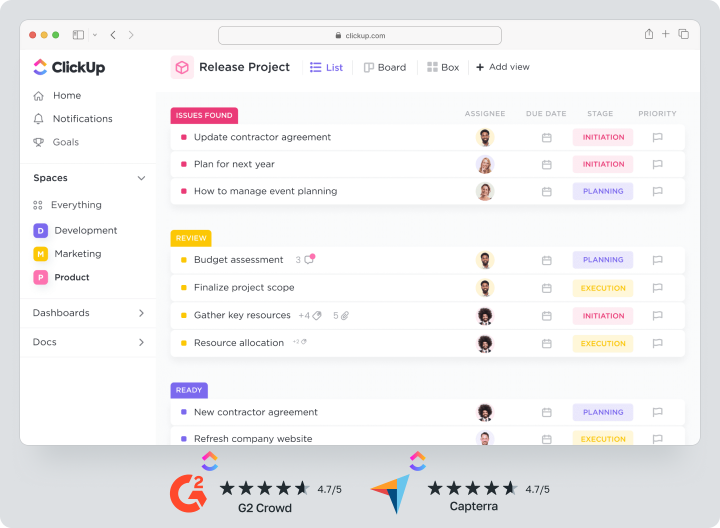
ClickUp provides deep customization, automation and selection of work tools. This eliminates the need to use several separate services, because ClickUp centralizes all directions.
| Cost | Free plan is available | Pricing starting at $7 per user/month |
Key features
- Multi-level tasks and subtasks.
This system allows for detailed structuring of work and distribution of responsibilities. - Gantt charts and calendar.
Provide visual planning and control of project deadlines. - Integrations with other services.
Supports integration with tools such as Slack, Google Drive and others to improve workflow.
Pros and cons
Benefits:- Flexible and scalable: suitable for both small teams and large organizations.
- One platform for all tasks: integrates project management, communication and document management functions.
- Ready-made process templates: the ability to select templates for the work of a specific area or direction.
- Adaptation time: due to the extensive functionality, new users may need time to fully master the platform.
In such cases, it is worth paying attention to the level of technical support, the speed of processing requests and the quality of problem solving. Worksection has an average response time of 3 minutes from a tech support manager. - Cost: as the number of users increases, the total cost can increase significantly.
Notion
Notion is a versatile platform that combines note-taking, project management and database management. The system is suitable for teams and individual users.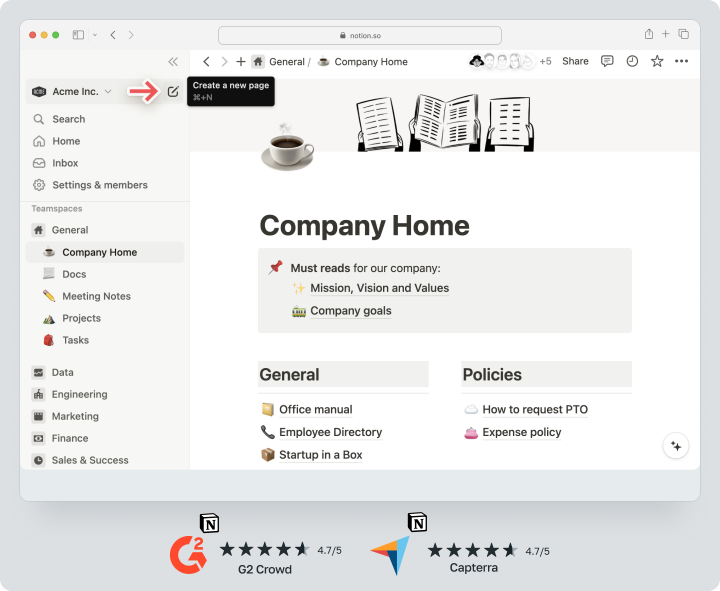
The main advantage of Notion is its flexibility and versatility. Notion allows you to create not only kanban boards, but also tables, lists, calendars, as well as documentation and knowledge bases in a single space.
| Cost | Free plan is available | Price from $10 per user/month |
Key features
- Databases.
They allow collecting and systematizing information related to the project in one place with access for all project participants. - Template diversity.
Notion offers a wide range of ready-made templates for different tasks, which speeds up workflow customization. - Real-time collaboration.
Users can simultaneously edit documents, leave comments and mention colleagues.
Pros and cons
Benefits:- Customization flexibility: Notion allows users to create and customize pages and databases as they see fit, tailoring them to specific tasks and processes.
- One place for information: Combining notes, tasks, and documents in one place makes it easier to access information and reduces the need to use multiple applications.
- Long adaptation time: Due to the extensive functionality, new users may need time to fully familiarize themselves with all the features.
- Limited offline access options: Notion requires a constant internet connection for full operation.
Wrike
Wrike is designed for medium to large teams that need advanced planning and coordination functions. The system offers deep capabilities for managing complex projects and resources.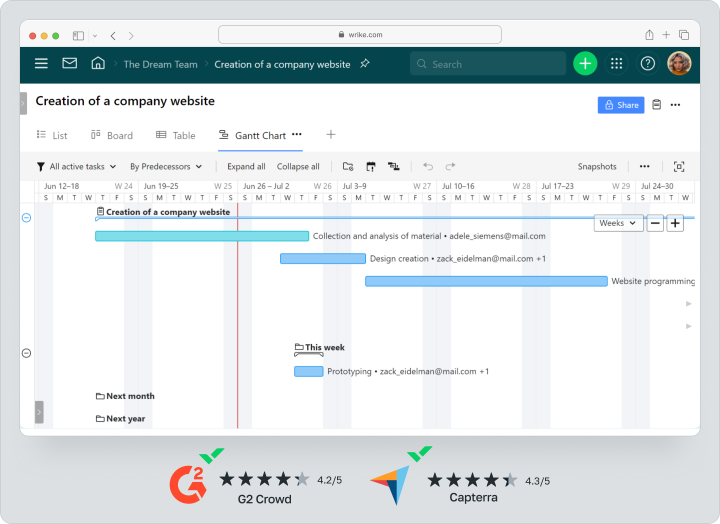
Wrike’s main advantage over Trello is its ability to scale and adapt to the needs of large organizations. Wrike provides built-in time tracking tools, advanced Gantt charts and the ability to customize complex workflows, which sets it apart from other alternatives.
| Cost | Free plan is available | Price from $10 per user/month |
Key features
- Interactive Gantt charts.
Allows you to visually plan projects, establish dependencies between tasks and track progress in real time. - Resource Management.
Tools for distributing workload among employees to optimize resource utilization and prevent overload. - Customizable workflows.
Ability to create and automate unique processes that match the specifics of a team or project.
Pros and cons
Benefits:- Scalability: Suitable for large teams and projects with complex structures, ensuring effective management at all levels.
- Built-in analytics tools: Provides detailed reports and metrics to evaluate performance and make informed decisions.
- Integration with other services, which is important for centralizing processes in a single tool.
- Difficult to learn: Due to the rich functionality, new users may need time to adapt and learn how to use the platform.
- Cost for small teams: Pricing may not be favorable for small teams.
MeisterTask
MeisterTask has an intuitive interface and flexible customization, making it attractive to small and medium-sized teams. The main advantage of MeisterTask is its ease of use and flexibility of customization.
The service offers advanced automation and integration capabilities, allowing teams to create customized workflows without unnecessary complexity. In addition, the platform supports integration with various services such as Slack, GitHub and others.
| Cost | Free plan is available | Price from $7 per user/month |
Key features
- Task Automation.
Set up automatic actions to speed up workflows. - Customizable projects and boards.
Create customized workspaces to meet the needs of the team.
Pros and cons
Benefits:- Intuitive interface: Easy to learn for new users.
- Flexible customization: Can be adapted to different workflows.
- Extensive integration capabilities: Support for multiple third-party services to improve collaboration.
- Limited functionality for large projects: May not fully meet the needs of large teams with complex projects. For such tasks, you need a Worksection-like system, which allows you to split the task into several subtasks with their own terms and executors.
- Cost: A paid subscription is required to access advanced features.
Jira
Jira is developed by Atlassian. The system is widely used by technical teams to organize software development processes.
Jira provides advanced capabilities to support Agile methodologies and deep customization of workflows. The main advantage of Jira is its ability to support the full software development cycle, including sprint planning, backlog management and bug tracking.
| Cost | Free plan is available | Pricing starting at $8.15 per user/month |
Key features
- Support for Agile methodologies.
Tools for managing sprints, backlog and storypoints, which facilitates efficient planning and execution of tasks. - DevOps integration.
Ability to connect with CI/CD tools such as Jenkins and Bamboo to automate testing and deployment. - Flexible workflow customization.
Custom statuses, fields and automation allow the system to be tailored to the specific needs of the team.
Pros and cons
Benefits:- Extensive customization options: Allows you to customize the system to fit your team’s unique processes.
- In-depth analytics and reporting: Built-in tools to monitor progress and performance.
- Scalability: Suitable for teams of any size, from small groups to large organizations.
Disadvantages:
- Difficult to learn: Due to the technical profile functionality, users without experience may need time to adapt. If you
- Cost: For small teams or startups, the paid rates can be high.
If you are looking for basic project management functionality and don’t want to overpay for functionality for technical teams, you should try Worksection. The system provides all the tools you need at an affordable price.
Basecamp
Basecamp is a simple and effective collaboration tool. The system brings together tasks, files, discussions and schedules in one place. Basecamp is ideal for teams looking for a simple and effective project management solution.
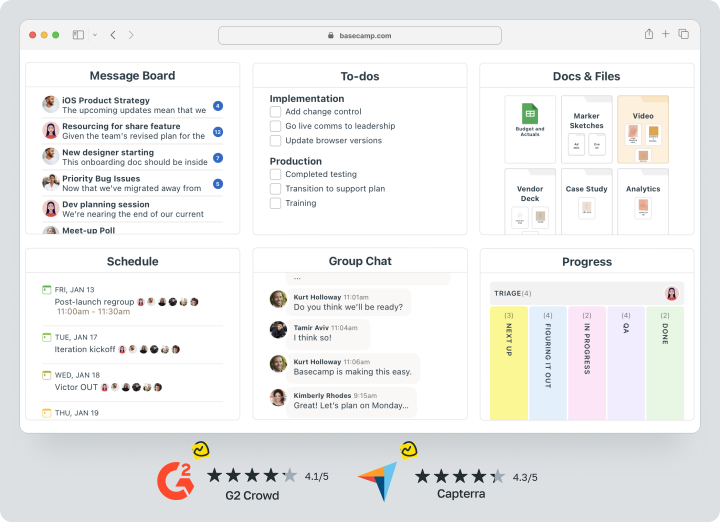
The service emphasizes communication and transparency of processes. A set of basic functions allows teams to fully manage projects without additional integrations.
| Cost | Free plan is available | Pricing starting at $15 per user/month |
Key features
- Centralized project management.
Combine all project elements — tasks, files, discussions and schedules — in one place. - Team communication tools.
Built-in chat rooms and discussion boards facilitate effective interaction between team members. - Notifications and reminders.
The notification system helps keep everyone up to date on current events and deadlines.
Pros and cons
Benefits:- Intuitive interface: Easy to learn and use for all team members.
- All necessary functionality: No need for additional integrations due to the presence of basic project management tools in one platform.
- Limited customization: Fewer opportunities to customize to the specific needs of the team compared to other platforms.
- Lack of features for the work of technical teams. For example, to work on sprints.
ProofHub
ProofHub is a platform for teams and collaboration. The system helps optimize workflows and increases team productivity.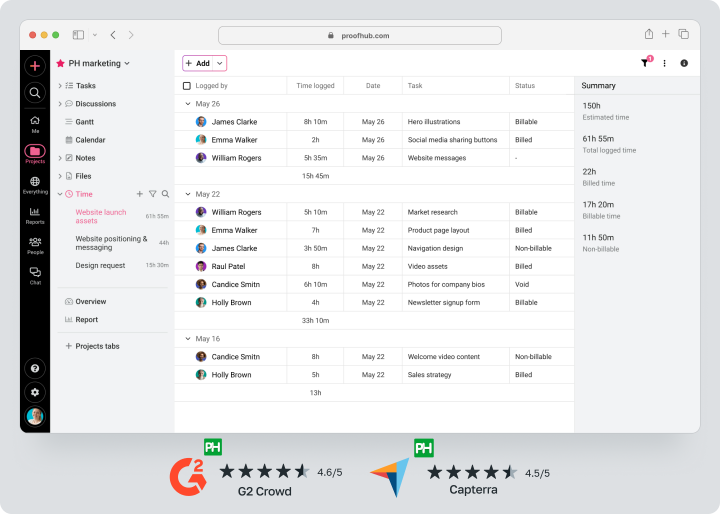
The service offers built-in time tracking tools and a Gantt chart. ProofHub provides centralized file storage, making it easy to access and share documents within the team.
| Cost | Free plan isn’t available | Price from $45 per month |
Key features
- Project management
Creating and customizing projects with the definition of goals, milestones and tasks, as well as assigning responsible persons. - Time tracking
The built-in time tracker allows you to monitor the time spent on tasks to help improve efficiency. - Gantt charts
Visualize projects with timelines and dependencies between tasks for more accurate planning.
Pros and cons
Benefits:- Versatility: Suitable for teams of any size and from different industries, providing a wide range of project management tools.
- Ease of use: An intuitive interface ensures easy learning and quick user adoption.
- Single platform: Brings all the tools you need in one place, eliminating the need for multiple separate applications.
- Limited integrations: Compared to some competitors, ProofHub offers fewer integrations with third-party services.
- Mobile app: Requires improvements to provide more stable operation and full functionality on mobile devices.
A comparison table of the best Trello alternatives
When choosing an alternative to Trello, it is important to consider the functionality, how well the tool fits the size of the team, the specifics of workflows and budget. This table will help you choose the most suitable tool to replace Trello depending on the specifics of your business.Title | Optimal command size | What tasks are suitable for | Minimum price per user |
Worksection | Small and medium | Project management, robot on an hourly basis, reporting | From $3.4 |
Asana | Medium and large | Task automation, Agile, reporting | From $10.99 |
Monday.com | Medium and large | Flexible process customization, analytics | From $9 |
ClickUp | Any size | Gantt charts, SCRUM, automation | From $7 |
Notion | Small and medium | Knowledge bases, kanban boards, task management | From $10 |
Wrike | Medium and large | Corporate project management | From $10 |
MeisterTask | Small | Simple task management, kanban | From $7 |
Jira | Medium, large, IT teams | Agile, DevOps, development management | From $8.15 |
Basecamp | Small and medium | Collaboration, team management | From $15 |
ProofHub | Medium and large | Integrated project management | From $45/month (fixed price) |
Which platform to choose in 2025?
If you need a universal tool that can be easily adapted to different processes, Worksection may be the best option. It is a balanced solution with a clear interface, detailed analytics and support for working on an hourly basis. Asana has similar functionality, where the focus is on flexibility and easy-to-use reports. ClickUp is more suitable for those who want to work out detailed workflows with Gantt charts and custom fields of settings.
For those looking for a tool with a focus on collaboration, Monday.com and Wrike are worth considering. They help to establish interaction within the team, quickly distribute tasks and track fulfillment without unnecessary bureaucracy. In IT, Jira is most often used, as it supports Agile methodologies and integrations with DevOps tools.
Small businesses are more comfortable working with Notion, Basecamp or MeisterTask. These platforms are easier to learn, but allow you to effectively manage tasks without an overloaded interface and complicated settings. And if you are on a tight budget, you should pay attention to Worksection, ProofHub and MeisterTask. They offer favorable rates for their users.
Each of these platforms is capable of replacing Trello. Before choosing one, you should determine which features are really important for your team. Sometimes convenience and simplicity are more important than dozens of additional features. Therefore, in the process of analyzing Trello analogs, it is important to determine which parameters are in priority for you.
Frequently Asked Questions (FAQ)
Which Trello alternative is best for small businesses?
For small teams, Worksection is one of the best alternatives to Trello. The platform is easy to learn and offers quality support at all stages of work. You can turn to experts who will help you adapt the system to your team’s tasks and optimize workflows.
Unlike Trello, Worksection provides advanced functionality required for effective project management. The system has built-in reports, time tracking, task control, Gantt chart, calendar, and flexible customization of roles and access levels. All key project management tools are gathered in one meat and are available at a favorable price.
Are there any free analogs to Trello?
Yes, but with limitations. Many services offer free plans, but they have limited functionality, such as limiting the number of users, tasks, or file storage. If you need access to all features, you will have to consider paid plans.
Among all alternatives, Worksection offers some of the most favorable conditions on the free plan. You can add up to 5 users and manage two projects at the same time. You will have kanban board and task manager tools at your disposal. This is a great solution for small teams that are just starting out and want to test the system before a large-scale implementation.
How is Worksection different from Trello?
Worksection offers an extended set of built-in tools for project and resource management, eliminating the need for additional integrations and costs. All core functions are already included in the platform, providing convenience and efficiency without complex customizations.
One of the main advantages of Worksection over Trello is the built-in Gantt chart. It is especially useful for industries where precise planning of deadlines is important: construction, manufacturing, architecture. Trello lacks this feature, which makes it difficult to control the stages of tasks on the timeline.
Another important advantage is the built-in time tracker. In Trello, it is available through third-party integrations, whereas in Worksection time tracking is included in all paid tariffs. This helps to control employee workload, analyze work efficiency and generate reports on used resources without additional services.